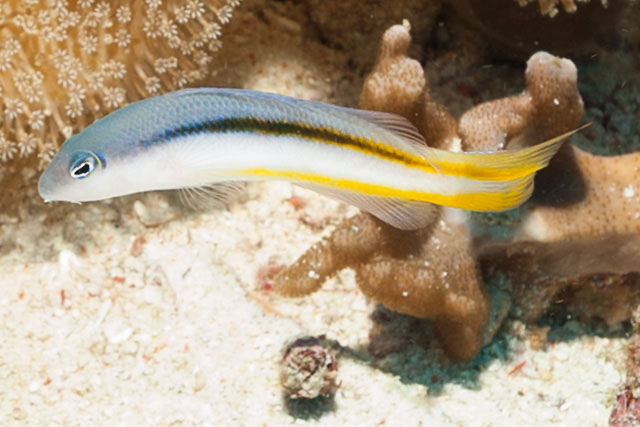| Pseudochromidae (Dottybacks), subfamily: Pseudochrominae |
| 5.96 cm SL (male/unsexed) |
|
reef-associated; marine; depth range 10 - 45 m |
| Pacific Ocean: Indonesia (endemic to the Raja Ampat Islands). |
|
Dorsal spines (total): 3-3; Dorsal soft rays (total): 24-25; Anal spines: 3-3; Anal soft rays: 14-14; Vertebrae: 26-26. This species differs from other pseudochromids in having the following set of characters: D III,24-25, usually III,24; A III,14; pelvic-fin rays I,5; anterior tip of palatine tooth patch directed medially behind posterolateral arm of vomerine tooth patch; upper part of body with dark (dark grey to black in life) longitudinal stripe, when present it is extending horizontally to or towards caudal-fin base; scales in lateral series 39-43; circumpeduncular scales 20-21, usually 20 (Ref. 89094).
Description: Characterized by adult male largely whitish to pale gray with golden brown zone on nape, extending along upper back to below posterior dorsal fin, filamentous extension on each caudal fin lobe; adult female with grey upper portion of head and back, blackish to dark brown stripe from eye to middle of caudal fin, lower head and middle of side with broad zone of white, yellow zone just below; juvenile yellowish overall except upper portion of head and sides with broad zone of dark brown; anterior lateral line scales 28-34; predorsal scales 15-22; depth of body 25.0-29.0 % of SL (Ref. 90102). |
| This species is generally found around isolated, small coral and rock outcrops in both silty and clear water reef environments, usually in about 10-45 m depth (sometimes seen as deep as 60 m). Occurs solitarily or in small loose groups, is relatively curious and easy to photograph, though it invariably retreats into crevices or under coral heads when approached too closely (Ref. 89094). |
|
Not Evaluated (N.E.) Ref. (130435)
|
| harmless |
|
Source and more info: www.fishbase.org. For personal, classroom, and other internal use only. Not for publication.

